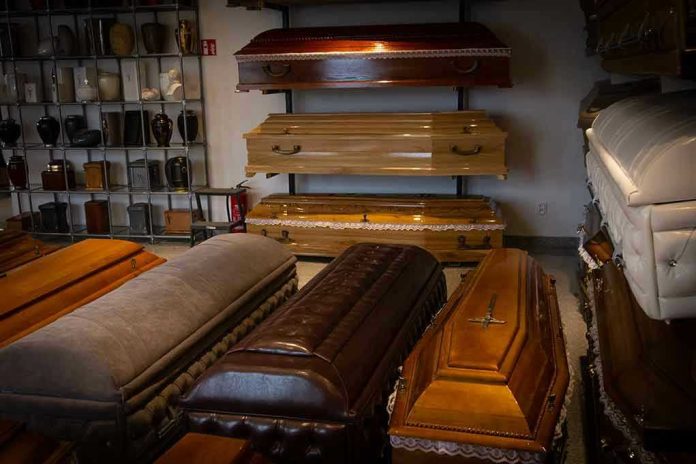
A Thai grandmother, moments away from cremation, knocked her way out of her own coffin—shattering not only death’s certainty but also the complacency of rural healthcare and family rituals.
Story Overview
- A 65-year-old Thai woman awoke inside her coffin just before cremation after being mistakenly declared dead by her family.
- The incident exposes alarming gaps in rural healthcare and the dangers of layperson death declarations.
- The story went viral after being caught on video, triggering public debate over death certification protocols.
- Medical experts later attributed her apparent death to severe hypoglycemia, not actual cessation of vital signs.
Death Assumed, Life Overlooked: How a Family’s Ritual Nearly Turned Fatal
Chonthirot, a 65-year-old Thai woman, had spent two years bedridden in her rural Phitsanulok home. On the morning of November 23, 2025, her family found her unresponsive, assumed she was dead, and placed her in a coffin for a four-hour journey to a Bangkok temple. Untrained in medical assessment and desperate for a respectful—yet free—farewell, her family took charge of what they believed was the final chapter of her life. Their actions highlight the practical realities faced by rural families: limited medical access, cultural reliance on temples for funerals, and the normalization of non-professional death declarations.
Upon arrival at the temple, as monks and mourners gathered to perform cremation rites, faint knocking from inside the coffin jolted the somber proceedings. Temple worker Thammanun acted quickly, opening the lid to find Chonthirot alive—shaken, swatting at flies, and gasping for air. The dramatic rescue unfolded on video, rapidly circulating online and turning a routine funeral into a viral cautionary tale. Her brother, Mongkol, described shock and relief, his testimony echoing the trauma that rippled through the family and community.
Medical Missteps and Systemic Weaknesses: The Hidden Dangers of Layperson Death Declarations
Doctors later determined Chonthirot’s “death” was not true death but severe hypoglycemia—dangerously low blood sugar that mimicked the appearance of death. Without professional medical evaluation, a reversible medical episode nearly became a fatal error. In rural Thailand, such misdiagnoses are not isolated. The incident exposes systemic vulnerabilities, where poverty and inadequate healthcare infrastructure leave families to navigate death’s threshold with little support. The temple’s role as a funeral provider underscores a broader dependence on community institutions to fill gaps left by the healthcare system.
Chonthirot’s survival after a lengthy coffin journey is extraordinary, yet it’s a stark reminder for families and officials alike. Medical professionals emphasize the necessity of proper death verification, especially in cases involving chronic illness or metabolic conditions. Scholarly voices in public health point to chronic underinvestment in rural medicine and call for reforms: standardized death certification, mandatory medical sign-off before cremation, and greater rural outreach. The event’s virality amplifies these calls, as video evidence and coordinated news coverage make denial or minimization impossible.
Public Reaction, Policy Pressure, and the Future of Death Certification in Thailand
The immediate aftermath saw widespread shock, relief, and debate. Chonthirot’s family endured emotional whiplash, from mourning to celebration. The local community, witness to both the error and the miracle, began questioning the reliability of traditional death declarations. Nationally, the story catalyzed discussion on the adequacy of rural healthcare and funeral practices. Free cremation services, vital for the poor, now face scrutiny—can charitable rituals coexist with necessary medical safeguards?
Economically, the case highlights the dependence of impoverished families on temples for end-of-life services. Socially, trust in non-medical death assessments has eroded, prompting calls for policy review. Politically, attention has turned to rural healthcare funding and training. The funeral industry may face new regulations, while healthcare officials debate expanding training for laypersons and enforcing stricter protocols. For rural communities, Chonthirot’s ordeal is both a warning and a rallying cry for reform.
Expert Commentary and the Broader Lessons of a Near-Fatal Mistake
Medical and funeral industry experts converge on the need for change. Mandatory medical confirmation before cremation, improved training for rural families, and investment in mobile health services top the list of recommendations. Academic analysis situates the incident within global patterns of death misdiagnosis, emphasizing the especially acute risks in resource-limited settings. The consensus among professionals is clear: reliance on tradition and family intuition is no substitute for clinical verification.
Media coverage has been unanimous in its factual recounting, with NDTV and Daily Mail providing consistent reports corroborated by Baku.ws. The absence of contradictions lends authority to the story and increases pressure for policy response. For Thailand—and any society balancing tradition, poverty, and medical uncertainty—Chonthirot’s ordeal is a wake-up call. The line between life and death is thinner than we think; without proper safeguards, it may be crossed far too soon.
Sources:
NDTV: Moments Before Cremation, “Dead” Thai Woman Awakens Inside Coffin
Baku.ws: Woman Came Back to Life in Coffin Minutes Before Cremation in Thailand









